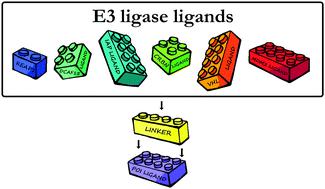当前位置:
X-MOL 学术
›
Chem. Soc. Rev.
›
论文详情
Our official English website, www.x-mol.net, welcomes your
feedback! (Note: you will need to create a separate account there.)
E3 ligase ligand chemistries: from building blocks to protein degraders
Chemical Society Reviews ( IF 40.4 ) Pub Date : 2022-04-08 , DOI: 10.1039/d2cs00148a Izidor Sosič 1 , Aleša Bricelj 1 , Christian Steinebach 2
Chemical Society Reviews ( IF 40.4 ) Pub Date : 2022-04-08 , DOI: 10.1039/d2cs00148a Izidor Sosič 1 , Aleša Bricelj 1 , Christian Steinebach 2
Affiliation

|
In recent years, proteolysis-targeting chimeras (PROTACs), capable of achieving targeted protein degradation, have proven their great therapeutic potential and usefulness as molecular biology tools. These heterobifunctional compounds are comprised of a protein-targeting ligand, an appropriate linker, and a ligand binding to the E3 ligase of choice. A successful PROTAC induces the formation of a ternary complex, leading to the E3 ligase-mediated ubiquitination of the targeted protein and its proteasomal degradation. In over 20 years since the concept was first demonstrated, the field has grown substantially, mainly due to the advancements in the discovery of non-peptidic E3 ligase ligands. Development of small-molecule E3 binders with favourable physicochemical profiles aided the design of PROTACs, which are known for breaking the rules of established guidelines for discovering small molecules. Synthetic accessibility of the ligands and numerous successful applications led to the prevalent use of cereblon and von Hippel–Lindau as the hijacked E3 ligase. However, the pool of over 600 human E3 ligases is full of untapped potential, which is why expanding the artillery of E3 ligands could contribute to broadening the scope of targeted protein degradation. In this comprehensive review, we focus on the chemistry aspect of the PROTAC design process by providing an overview of liganded E3 ligases, their chemistries, appropriate derivatisation, and synthetic approaches towards their incorporation into heterobifunctional degraders. By covering syntheses of both established and underexploited E3 ligases, this review can serve as a chemistry blueprint for PROTAC researchers during their future ventures into the complex field of targeted protein degradation.
中文翻译:

E3 连接酶配体化学:从构件到蛋白质降解剂
近年来,能够实现靶向蛋白质降解的蛋白水解靶向嵌合体(PROTACs)已证明其作为分子生物学工具的巨大治疗潜力和有用性。这些异双功能化合物由蛋白质靶向配体、合适的接头和与所选 E3 连接酶结合的配体组成。成功的 PROTAC 诱导三元复合物的形成,导致 E3 连接酶介导的靶蛋白泛素化及其蛋白酶体降解。自该概念首次展示以来的 20 多年中,该领域已大幅增长,主要是由于非肽 E3 连接酶配体发现的进步。开发具有良好物理化学特性的小分子 E3 粘合剂有助于 PROTAC 的设计,它们以打破既定的小分子发现指南规则而闻名。配体的合成可及性和许多成功的应用导致了 cereblon 和 von Hippel-Lindau 作为被劫持的 E3 连接酶的普遍使用。然而,超过 600 种人类 E3 连接酶库充满了未开发的潜力,这就是为什么扩大 E3 配体的火炮有助于扩大靶向蛋白质降解的范围。在这篇综合综述中,我们通过概述配体 E3 连接酶、它们的化学性质、适当的衍生化以及将它们掺入异双功能降解剂的合成方法,重点关注 PROTAC 设计过程的化学方面。通过涵盖已建立和未充分利用的 E3 连接酶的合成,
更新日期:2022-04-08
中文翻译:

E3 连接酶配体化学:从构件到蛋白质降解剂
近年来,能够实现靶向蛋白质降解的蛋白水解靶向嵌合体(PROTACs)已证明其作为分子生物学工具的巨大治疗潜力和有用性。这些异双功能化合物由蛋白质靶向配体、合适的接头和与所选 E3 连接酶结合的配体组成。成功的 PROTAC 诱导三元复合物的形成,导致 E3 连接酶介导的靶蛋白泛素化及其蛋白酶体降解。自该概念首次展示以来的 20 多年中,该领域已大幅增长,主要是由于非肽 E3 连接酶配体发现的进步。开发具有良好物理化学特性的小分子 E3 粘合剂有助于 PROTAC 的设计,它们以打破既定的小分子发现指南规则而闻名。配体的合成可及性和许多成功的应用导致了 cereblon 和 von Hippel-Lindau 作为被劫持的 E3 连接酶的普遍使用。然而,超过 600 种人类 E3 连接酶库充满了未开发的潜力,这就是为什么扩大 E3 配体的火炮有助于扩大靶向蛋白质降解的范围。在这篇综合综述中,我们通过概述配体 E3 连接酶、它们的化学性质、适当的衍生化以及将它们掺入异双功能降解剂的合成方法,重点关注 PROTAC 设计过程的化学方面。通过涵盖已建立和未充分利用的 E3 连接酶的合成,













































 京公网安备 11010802027423号
京公网安备 11010802027423号